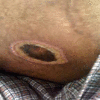Burn from car seat heater in a man with paraplegia: case report
- PMID: 21756574
- PMCID: PMC3127368
- DOI: 10.1179/2045772311Y.0000000005
Burn from car seat heater in a man with paraplegia: case report
Abstract
Objective/background: Heated car seats are a common feature in newer automobiles. They are increasingly being recognized as potential hazards as there have been multiple reports of significant burns to its users. The potential for harm is considerably increased in those with impaired sensation with the possibility of a devastating injury.
Methods: Case report and literature review.
Results: A 26-year-old male with a T8 ASIA A paraplegia presented to the outpatient clinic for management of a hip burn. Two weeks prior to his visit he was driving a 2004 Jeep Cherokee for approximately 30 minutes. He was unaware that the driver's side seat warmer was set on high. He denied that his seat belt was in direct contact with the skin of his right hip. He presented to an acute care hospital that evening with a hip burn where he was prescribed silver sulfadiazine cream and instructed to apply it until his scheduled follow-up clinic visit. In clinic, the hip wound was unstageable with approximately 95% eschar. A dressing of bismuth tribromophenate in petrolatum was applied to the wound and he was instructed to change the dressing daily. This was later changed to an antimicrobial alginate dressing. The ulcer eventually healed.
Conclusions: This case illustrates the significant risk of car seat heaters in individuals with spinal cord injuries or neurological impairment who have decreased sensation. Additionally, it highlights an atypical area of potential for burn. Furthermore, it emphasizes the need for a heightened awareness for this unique and dangerous situation.
References
-
- Beckenstein MS, Beegle P, Hartrampf CR. Thermal injury to TRAM flaps: a report of five cases. Plast Reconstr Surg 1997;99(6):1606–9 - PubMed
-
- Gowaily K, Ellabban MG, Iqbal A, Kat CC. Hot water bottle burn to reconstructed breast. Burns 2004;30(8):873–4 - PubMed
-
- Nahabedian MY, McGibbon BM. Thermal injuries in autogenous tissue breast reconstruction. Br J Plast Surg 1998;51(8):599–602 - PubMed
-
- Ozgenel Ege GY, Ozcan M. Heating-pad burn as a complication of abdominoplasty. Br J Plast Surg 2003;56(1):52–3 - PubMed
Publication types
MeSH terms
LinkOut - more resources
Full Text Sources
Medical

